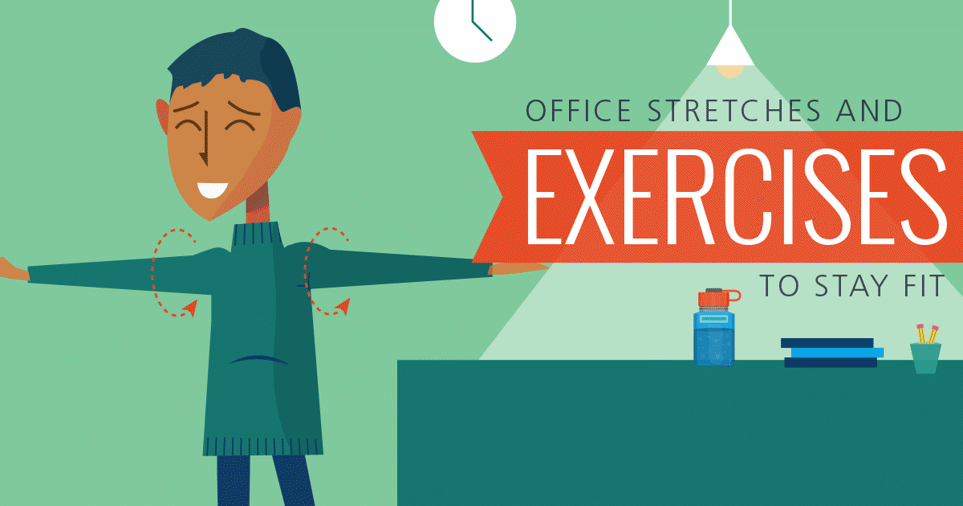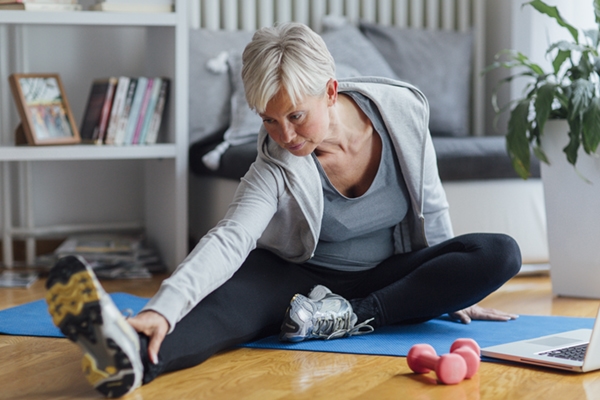Office stretches and exercises to stay fit
Apr 23, 2022

Doing anything for too long in the workplace — even if that workplace is at home — can have negative health effects, whether it's sitting at your desk, staring at your computer screen or working through lunch.
The primary message that physical therapists at Adventist Health Portland want people to remember is that for every 30 minutes of sitting, standing or typing, do 30 seconds of the opposite. That means getting out of your chair to stretch, taking a walk during lunch, sitting down for a relaxing lunch, or switching to a standing position at your desk.
Staying in the same position or repetitive actions for hours on end can have negative consequences on your joints, back and neck. That includes standing too much. The human body is designed to move, and regular movement will keep circulation up while regulating blood sugar levels.
Check out our infographic for stretches and tips!
Small changes at the office can improve your health

"There are a number of small changes people can make in the office to keep their joints strong, increase circulation and improve overall health and wellness," says Anne Murray, PT, MSPT, a physical therapist at Adventist Health Physical Therapy in Clackamas. "A few minor changes to your daily routine and taking a few minutes each day to stretch can make a huge difference in how you feel."
Murray and other Adventist Health physical therapists have a few stretches, exercises and tips that will help keep you energized and focused throughout the day while improving health.
"Stretching regularly and getting up out of your desk is not only good for your health, but also productivity," Murray adds.
That's because being sedentary for more than one hour can lower blood sugar levels, boost snack cravings and reduce blood flow to your extremities, including the brain. Low blood flow to the brain leads to reduced productivity and more errors, which is also bad for business. Getting away from your desk for that short walk or lunch with a coworker will actually be beneficial, and there's proof to help convince your supervisor.
Workplace stretches to improve circulation and prevent cramping
You don't need an entire gym floor to do your stretches. In fact, you don't even need to get on the floor.
There are several stretches you can do while sitting or standing at your desk that will help improve joint health and posture. These are also great to remember when watching a sports game, taking a long road trip or traveling on an airplane.
- Head twister – Keeping your chin parallel with your shoulders, look left and then right, spending about 10 seconds on each side.
- Neck bender– With your hands at your side, relax, take a breath and alternate leaning your head from the left to the right, pausing for about 10 seconds on each side.
- Chin tuck – With your shoulders squared, drop your chin to your chest and hold the position for 20-30 seconds to stretch the muscles in your neck.
- Shoulder rolls – With your shoulders square and arms at your side, lift and rotate your shoulders backward, and then forward.
- Executive stretch – With fingers locked together and straightened arms, push your palms toward the sky to stretch your upper back.
- Back arch – Put your hands to your lower back and arch your head while leaning backward.
Workplace exercises and tips to stay fit and healthy
- Take a walk– Primary care providers recommend that people take at least 10,000 steps per day. To help you reach that goal, walk to the office if it's nearby, go for a walk during lunch, park farther away from the building or even walk around your office while taking client phone calls.
- Stand up – Sitting for too long can lead to poor posture, an achy back and decreased blood circulation. Try switching to a standing desk if possible, marching in place, or taking little breaks to stand up and move around the office, whether it's grabbing a cup of tea or using the restroom.
- Take the stairs – Hopping into the elevator is far too easy, even when you're just headed to the second or third floor. Try bypassing the elevator doors and climbing those flights of stairs each morning. For people who work on the top floor, try getting off the elevator a couple floors early and walking up the rest of the way.
- Wall sits – Stand against the wall and lower yourself into a sitting position. Hold for 10 or more seconds and then rise back into a standing position. Doing this can help improve leg strength and endurance.
- Chair squats – Act as though you're going to sit down in your desk chair, but before actually sitting, rise back into a standing position. Repeat 10-15 times. This will help strengthen and tone your legs, from the glutes to the hamstrings.
- Core workout – There are a number of silent exercises you can do at the office to strengthen your core and give your abs a workout. Try tightening your stomach for 5-10 seconds while sitting at your desk or walking to the lunchroom. Or while sitting in a swivel chair, raise your feet off the ground, grip your desk and then twist from side to side while keeping your abs clenched. Remember that good posture in general will help improve your core muscles.


